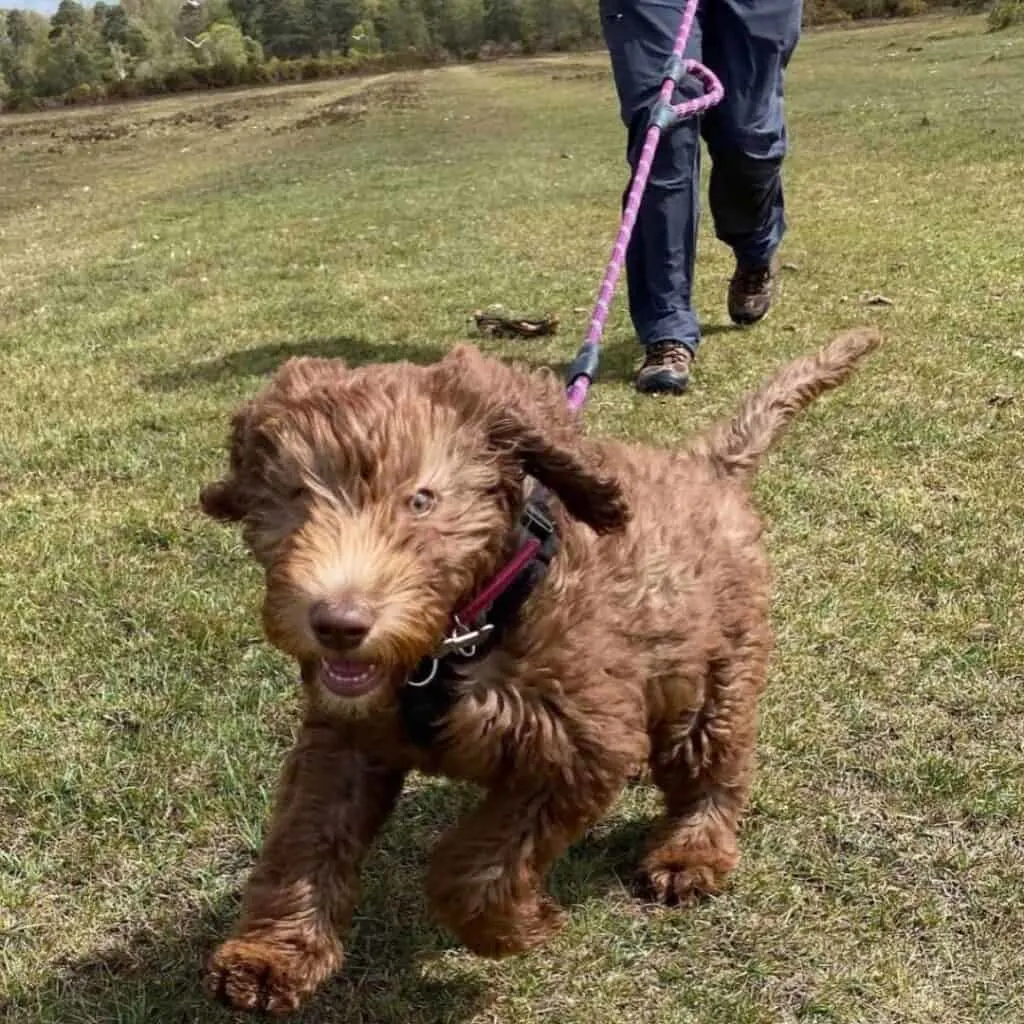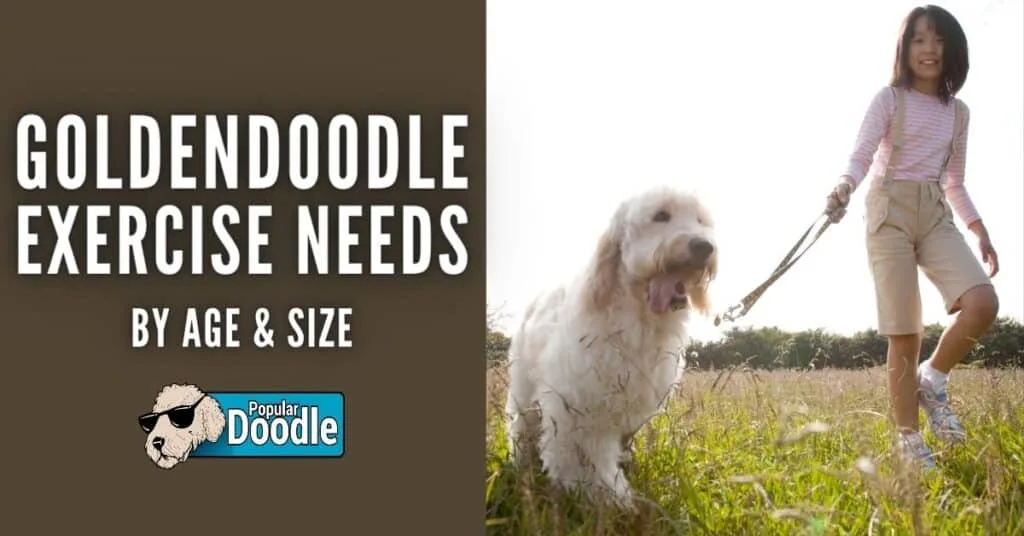
One of the easiest ways to ensure you have a happy, healthy, and well-behaved Labradoodle is making sure they get enough physical activity on a daily basis.
There are minimum Labradoodle exercise needs that you should be aware of as a current or future owner of this breed. Just as importantly, you don’t want to over-exercise your Labradoodle puppy, as you could easily hinder their health and development without even realizing it!
How Much Exercise Do Labradoodles Need?
Being an active breed, an adult Labradoodle needs anywhere from 30-120 minutes of exercise, 1-2 times per day. Where your Labradoodle falls on this range depends on their personality, size, and age. Labradoodle puppies should be exercised less—about 5 minutes per month of age, 1-3 times per day. This helps to avoid putting unnecessary stress on their developing joints.
The table below is a helpful guide that uses your Labradoodle’s age and size to estimate how much daily exercise they should get.
| Your Labradoodle's Age | Teacup / Toy Labradoodle Exercise Requirements | Mini Labradoodle Exercise Requirements | Standard Labradoodle Exercise Requirements |
|---|---|---|---|
| 2 Months (8 Weeks) | 10 Minutes 1-3x/day | 10 Minutes 1-3x/day | 10 Minutes 1-3x/day |
| 3 Months (12 Weeks) | 15 Minutes 1-3x/day | 10 Minutes 1-3x/day | 10 Minutes 1-3x/day |
| 4 Months (16 Weeks) | 20 Minutes 1-3x/day | 15 Minutes 1-3x/day | 15 Minutes 1-3x/day |
| 5 Months (20 Weeks) | 25 Minutes 1-3x/day | 20 Minutes 1-3x/day | 15 Minutes 1-3x/day |
| 6-12 Months | 30 Minutes 1-3x/day | 25 Minutes 1-3x/day | 20 Minutes 1-3x/day |
| 12 - 18 Months | 30-60 Minutes 1-2x/day | 30-60 Minutes 1-2x/day | 25 Minutes 1-3x/day |
| 18 - 24 Months | 30-60 Minutes 1-2x/day | 45-90 Minutes 1-2x/day | 30-60 Minutes 1-2x/day |
| Adult (2+ Years) | 30-60 Minutes 1-2x/day | 45-90 Minutes 1-2x/day | 60-120 Minutes 1-2x/day |
| Senior (8-12+ Years) | 20-30 Minutes 1-2x/day | 30-45 Minutes 1-2x/day | 30-60 Minutes 1-2x/day |
Keep in mind, this table is meant to provide a rough range, not an exact or definite figure. Your local veterinarian is your best resource when determining the proper exercise regimen for your specific dog.
The Dangers of Too Much or Too Little Exercise
Without enough exercise, Labradoodles can become overweight or obese. Having a chubby dog isn’t cute—it’s dangerous!
So many health problems in Labradoodles have obesity as a cause or contributing factor such as cancer, kidney disease, arthritis, and heart disease.
Your Labradoodle’s physical condition isn’t the only thing that will suffer due to not getting enough exercise. Behavioral issues like jumping, barking, and destructive behavior are often made worse by lack of physical activity.
Labradoodles tend to be an easy breed for trainability. So, if your dog is struggling with obedience, consider whether they’re getting enough exercise.
Keep in mind, sometimes too much of a good thing can be bad. That’s definitely the case when it comes to exercise, especially while you’re Labradoodle is still a puppy!
Until your dog reaches their full height and weight, their joints are still developing. Too much exercise or too vigorous of activities can mean life-long bone and joint problems for your Labradoodle.
Getting your Labradoodle the proper amount of exercise for their size and age may decrease their risk of many health issues, but there are no guarantees!
Getting a quality pet insurance policy will help ensure you’ll never have to sacrifice the best care for your Labradoodle based on what you can afford. I personally use Healthy Paws and they cover 90% of my veterinary bills!
What Do the Labradoodle Exercise Needs Depend On?
Age
The number one factor that influences Labradoodle exercise requirements is your dog’s age.
Puppies are curious, energetic, and love to play. However, their joints and bones are still just beginning to develop. Vigorous or extended periods of physical activity can permanently damage their development.
On the other hand, senior Labradoodles often don’t need as much exercise as younger dogs and would prefer to relax the majority of the day.
One thing puppies and older dogs both have in common is that they require lots of rest throughout the day for their bodies to recover.
Especially with all the excitement that comes with getting a new puppy, it can be tempting to push your Labradoodle’s exercise limits. Sure, your Labradoodle may be your go-to jogging or hiking buddy one day…but do them a favor and wait until they’re an adult!
Remember, puppies aren’t aware of their exercise limits and what is good or bad for their future development. It’s up to you as a responsible dog parent to help guide them in the right direction!
Keep reading, as we’ll give you some tips on how to get all that puppy energy out in a safe, controlled way!
Size

What size your Labradoodle will be when they’re fully-grown plays a huge role in how much they should be exercising.
Larger dog breeds, such as the Standard Labradoodle, tend to need more physical activity than their smaller counterparts. However, they won’t reach their full-grown height and weight until around their second birthday. That means their bones and joints are still developing and shouldn’t be put through a lot of stress until they’re done.
On the other hand, smaller dogs like the Teacup, Toy, or Mini Labradoodle sizes may need less exercise as adults, but they finish developing quicker. A Teacup Labradoodle, for example, may be done growing as early as 7-12 months in age.
Related: Mini Labradoodle vs Labradoodle: Which Size Should You Get? (QUIZ)
Your veterinarian will help determine exactly when your Labradoodle has finished growing. At that point, more strenuous activities like jogging and hiking can be incorporated in addition to longer exercise sessions!
Have a question to ask a veterinarian? Click here to be connected via live chat to a real, verified veterinarian!
As always, keep watch for signs of injury, heat exhaustion, or fatigue no matter how old your dog is. Be on the lookout for signs like excessive panting, drooling, or laying down.
Personality
While Labradoodles tend to be an active breed in general, each dog has a unique and individual personality. Some dogs are naturally couch potatoes while others are born to be athletes!
Genetics play a role in this and as a result which generation of Labradoodle your dog can make a difference. In general, the closer in DNA your puppy is to a Labrador Retriever, the more high-energy they will be. That being said, you should expect and be prepared for a Labradoodle of ANY generation to be high-energy.
At the end of the day, you’ll have to learn your Labradoodle’s personality and what their exercise needs are. To do this, watch for signs that they’re getting too little or too much physical activity.
Labradoodles that are over-exercised may show physical symptoms like sickness, limping, or avoiding going outside. While walking, they may pant excessively and choose to lie down instead of continuing. Don’t mistake this as laziness and force them to keep going.
On the other side of the coin, if your Labradoodle is being destructive or unusually naughty, more exercise may be a good way to calm them down. Exercise combined with mental stimulation does wonders for obedience training!

How Much Exercise Do Labradoodle Puppies Need?
Still unsure about how much exercise your Labradoodle puppy should be getting? Let’s go into some more detail!
Toy Labradoodle Puppy Exercise Requirements
Toy Labradoodles as well as Teacup Labradoodles typically don’t need as much exercise when they’re adults. However, they grow quickly to their full size so they can ramp up their physical activity early on.
When you bring home your Toy Labradoodle puppy at around 8 weeks, start them off with 10 minute play sessions or short potty-break walks 1-3 times per day.
Each month older they get, you can add 5 additional minutes to their daily exercise sessions. Still have them occur 1-3 times per day as needed.
When they reach a full year old, they can start their adult exercise requirements of 30-60 minute sessions, once or twice every day. For example, two 45 minute walks would be great. An hour walk and a 15 minute game of fetch in the backyard would do as well!
When they reach their golden years, scale back the exercise a little to 20-30 minute sessions once or twice per day.
Mini Labradoodle Puppy Exercise Requirements
Mini Labradoodles still can have a lot of energy despite their small statures!
For the first 3 months, exercise your Miniature Labradoodle in 10 minute sessions 1-3 times per day. When they reach 4 months in age, you can add 5 minutes to their maximum session time.
When they reach their first birthday, you can ramp up their exercise to 30-60 minute sessions occurring once or twice per day. You’ll begin to get a feel for your Labradoodle’s personality to see how much exercise they enjoy.
At 18 months in age, a Mini Labradoodle is likely full-grown and you can increase their exercise to the adult level of 45-90 minute sessions, one or two times each day.
At 8-12 years old when they start to slow down a bit, ease up their exercise routine to 30-45 minute sessions, once or twice a day. Remember, getting plenty of rest is key for the health and happiness of older dogs.
Standard Labradoodle Puppy Exercise Requirements
Standard Labradoodles are large, active dogs and need a lot of exercise. However, due to their growing joints, they need to be eased into this exercise very slowly.
For the first 5 full months of your Standard Labradoodle’s life, keep their exercise sessions to 15 minutes or less. Have multiple, short timeframes for walks or play each day to use up their puppy energy!
From 6-12 months in age, 20 minute exercise sessions are appropriate 1-2 times per day. From 12-18 months old, increase that to 25 minutes, once or twice a day.
When your Standard Labradoodle reaches 18 months in age, they can have 30-60 minute exercise sessions once or twice a day.
Finally, after they are two years old and considered an adult, they’ll need even more exercise. Plan for around 1-2 hours once or twice a day. Combine walking with other activities and games for best results!
As your Standard Labradoodles ages and becomes a senior, reduce their exercise to 30-60 minute sessions, 1-2 times per day. Remember, the lifespan of a Standard Labradoodle is shorter than the Toy and Mini versions of this breed. So, they’ll be considered a senior at 8 years old, and maybe even a little earlier.
How to Tire Out a Labradoodle Puppy (Safely!)
While walking is by far the most common way to exercise your puppy, there are so many more options to consider!
What type of exercise your Labradoodle puppy partakes in is just as important as how long they spend doing it. High-impact activities will damage a puppy’s bones and joints, even if they’re only done for a few minutes!
Dangerous Exercise Ideas for Labradoodle Puppies
- Jumping or Climbing – This includes both couches and stairs. Opt for lifting or carrying your pup when possible.
- Jogging or Running – Your Labradoodle shouldn’t be your jogging partner until they’re fully-grown and their joints can handle it.
- Catching Frisbees or Balls in the Air – Constantly jumping in the air can do a lot of damage to a puppy’s developing bones and joints. Keep your games of fetch low-impact.
- Long Hikes – Hikes are normally fairly lengthy. Combine that with potentially uneven trails, and they’re not great for your Labradoodle’s development.
Safe Exercise Ideas for Labradoodle Puppies
- Play Dates with Other Puppies – This not only provides a great opportunity for physical activity, but socialization as well! Keep in mind, puppies don’t always know their limits so keep those play dates short!
- Slow Walks on a Leash – Going slow allows your Labradoodle to sniff, which is great mental stimulation!
- Obedience Training – Training wears your puppy out both physically and mentally. Keep sessions short and fun!
- Short Games of Fetch or Tug – Thanks to the Retriever in them, Labradoodles usually love to play fetch. Keep games of fetch short and in-control. Avoid lots of jumping or other high-impact movements if possible.
Alternative Exercise Ideas for Labradoodles
Just because the weather is bad doesn’t mean that you can’t get your Labradoodle some much-needed exercise!
Here are a handful of creative ways to sneak in some fun physical and mental activity for your pup!
Snuffle Mat or Ball

Instead of feeding your Labradoodle out of a bowl, try using a snuffle mat or ball on some days!
If you’re not familiar, snuffle balls and mats use folded fabric flaps to hide your dog’s food. This makes them use their sense of smell and creativity to find it and get to it!
It may not seem like it uses a lot of energy, but mental stimulation can be just as tiring as physical activity!
There are lots of wonderful snuffle toy options available on Amazon and Etsy. However, if you prefer to make one yourself, we have a simple DIY snuffle ball tutorial here!
Hide and Seek
This is an easy, fun game for both you and your dog! Start with some easy locations and watch your pup search until they find you. Once they understand the game, start hiding in harder spots to give them a challenge!
Tug of War
This is a time-tested game that most dogs naturally love! It also does a great job of helping them reach their Labradoodle exercise needs!
Brain Games
These fun “brain games” for dogs will challenge your Labradoodle with a tough yet fun mental workout! They also do an amazing job of incorporating obedience training concepts that will make your dog naturally better-behaved.
How Far Can a Labradoodle Walk?
As a rule of thumb, Labradoodle puppies under 2 years old shouldn’t walk longer than 1-2 miles at a time. When your Labradoodle reaches their adult weight and height, they can walk 5-10 miles comfortably as long as their stamina is built up.
Don’t expect a dog who’s always been a couch potato to run a marathon right away! Additionally, remember that Teacup, Toy, and Mini Labradoodles have shorter legs than Standard Labradoodles. This means that a mile is “longer” and more strenuous for them.
You’ll also want to consider the speed you’ll be walking, the incline, and the temperature when deciding how far your Labradoodle should go!
Closing Thoughts
Meeting your Labradoodle’s exercise needs aren’t always easy. Particularly as a puppy, it can be a real balancing act getting them enough exercise while not overdoing it.
Hopefully, with the Labradoodle exercise requirements discussed above, you’ll have the information necessary to keep your dog healthy and happy for many years to come!









![What is a Parti Labradoodle? [Photo Gallery & FAQs] what-is-a-parti-labradoodle](https://populardoodle.com/wp-content/uploads/2021/07/what-is-a-parti-labradoodle-1024x536.jpg.webp)